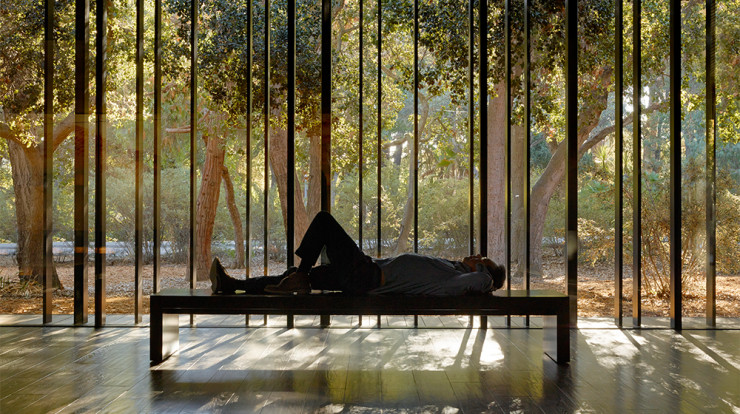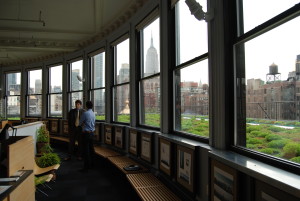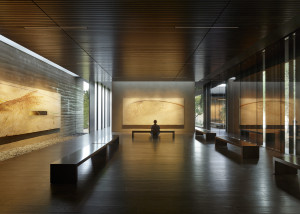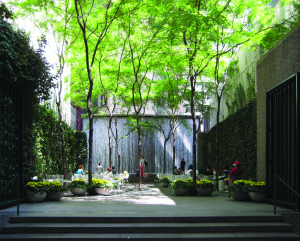

Features
Three New Case Studies in Biophilic Design
Rebecca Macies
Share
Learn more about our biophilic design work and services by emailing us at [email protected] and reading our reports, 14 Patterns of Biophilic Design and The Economics of Biophilia. Follow the conversation on twitter: @TerrapinBG | #14Patterns.
We’ve been busy continuing our research in biophilic design and finding projects all over the world that have used biophilic design to improve occupant experience. It is our hope that these case studies show how biophilic design can be applied through real-world examples. This month, we’re releasing the first three case studies, each of which looks at a specific project to highlight how the 14 patterns of biophilic design are applied, as well as the impact of these spaces have on the health and wellbeing of their occupants.
The projects span different building types, locations, scales, and uses. From urban parks and office buildings, to campuses, health care facilities, and residential buildings, biophilic design is applicable across industries and building types. The first three case studies review Paley Park in New York, the COOKFOX office renovation in New York, and the Windhover Contemplative Center at Stanford University in California.
Paley Park is a tiny park in a bustling area of Manhattan dominated by tall office buildings. The park, completed in 1967, was the first of what designer Robert Zion called “pocket parks”. These parks were intended to take advantage of small spaces in urban areas like New York City to provide a temporary escape. The park’s popularity has only increased over time, and is a perfect example of a biophilic urban acupuncture intervention. The park’s waterfall drowns out the sounds of the city and transports visitors to an urban oasis for the duration of their visit.

The COOKFOX studio has expansive views to a large greenroof and the New York skyline. Image copyright COOKFOX Architects.
At 641 Avenue of the Americas, a renovation transformed the divided interior and unused rooftop into an iconic green roof and open office plan. By combining much of the floor’s original detailing, including beautiful Corinthian columns, with the tenets of biophilic design, COOKFOX Architects created an office environment that reduces stress and promotes the wellbeing of their employees and visitors. Data from a post-occupancy survey shows in more detail the relationship between the patterns and wellbeing.

The Windhover Contemplative Center is a favorite spot on the Stanford campus. Image copyright Aidlin Darling Design.
Stanford University’s Windhover Contemplative Center blurs the line between art, architecture, and the natural landscape. Inspired by Nathan Oliveira’s Windhover series of paintings, and the role that the built environment can play in supporting mental health and wellbeing, Windhover acts as a resource for students and the campus community to connect with nature and reduce stress. The building’s design pulls visitors into the space, catching and holding their attention and sense of adventure. The building is lit up at night to remain safe and accessible at all hours, mindful of having the resource be available whenever it is needed.
There are examples of biophilic design everywhere. Long before we identified the 14 patterns, designers, architects, and planners have been creating spaces that support our health and wellbeing by connecting us to nature. We’re excited to showcase projects that are leading the way in biophilic design.
View and download the case study pdfs below:
- Paley Park Case Study – PDF (3.6 MB)
- 641 Ave of the Americas Case Study – PDF (1 MB)
- Windhover Contemplative Center Case Study – PDF (3.7 MB)
*Header image copyright Aidlin Darling Design, feature image courtesy of Bill Browning.
Filed under:
Rebecca Macies
Rebecca is the Director of Operations at Terrapin and has a background in natural resource policy and management. She is interested in how policy helps shape our relationship to nature, and how we can work with and learn from natural systems to address human needs.
Topics
- Occupant Comfort
- Materials Science
- Speaking
- LEED
- Terrapin Team
- Phoebe
- Community Development
- Greenbuild
- Technology
- Biophilic Design Interactive
- Catie Ryan
- Spanish
- Hebrew
- French
- Portuguese
- Publications
- Carbon Neutrality
- Environmental Values
- Conference
- Psychoacoustics
- Education
- Workshop
- Mass Timber
- Transit
- Carbon Strategy
- connection with natural materials
- interior design
- inspirational hero
- biophilia
- economics of biophilia
- Sustainability
- Systems Integration
- Biophilic Design
- Commercial
- Net Zero
- Resorts & Hospitality
- Energy Utilization
- Water Management
- Corporations and Institutions
- Institutional
- Ecosystem Science
- Green Guidelines
- Profitability
- Climate Resiliency
- Health & Wellbeing
- Indoor Environmental Quality
- Building Performance
- Bioinspired Innovation
- Biodiversity
- Residential
- Master Planning
- Architects and Designers
- Developers and Building Owners
- Governments and NGOs
- Urban Design
- Product Development
- Original Research
- Manufacturing
- Industrial Ecology
- Resource Management
- Sustainability Plans
- Health Care



